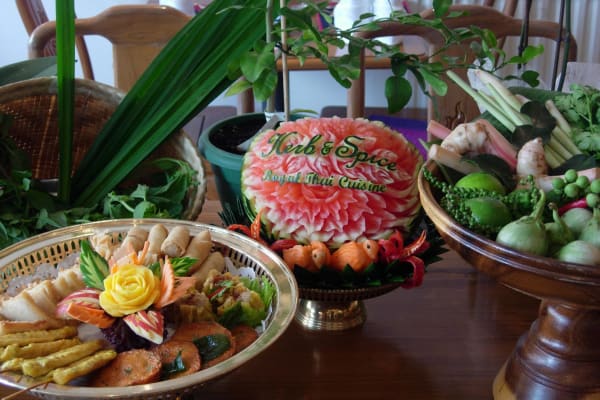Herb & Spice
Thai Restaurant
Friendly restaurant, with good food and a well presented and extraordinary service.
Thai cuisine is essentially a marriage of centuries-old Eastern and Western influences harmoniously combined into something uniquely Thai.
Thai food is internationally famous. Whether chili-hot or comparatively mild, harmony is the guiding principle behind each dish. Characteristics of Thai food depend on who cooked it, for what occasion, and where it is cooked. Dishes can be refined and adjusted to suit all palates. Originally, Thai cooking reflected the characteristics of a waterborne lifestyle. Aquatic animals, plants, herbs, and spices were major ingredients. Traditional Thai cooking methods were stewing, baking, and grilling. Chinese influences saw the introduction of frying, stir-frying, and deep-frying. From the 17th century onwards, culinary influences included Portuguese Dutch, French, and Japanese. Thais were significantly adapt to Siamese-ising™ foreign cooking methods, and substituting ingredients. The ghee used in Indian cooking was replaced by coconut oil, and coconut milk was covered for other dairy products. Overpowering pure spices were toned down and enhanced by fresh herbs such as lemongrass and galangal. Eventually, fewer and fewer spices were used in Thai curries, while the use of fresh herbs increased. It is generally acknowledged that Thai curries burn intensely, but briefly, whereas other curries, with strong spices, burn for longer periods. Instead of serving dishes in courses, a Thai meal is served all at once, permitting dinners to enjoy complementary combinations of different tastes. A proper Thai meal should consist of a soup, a curry dish with condiments, and a dip with accompanying fish and vegetables. The soup can also be spicy, but the curry should be replaced by a non-spiced item. There must be a harmony of tastes and textures within individual dishes and the entire meal.
- Wheelchair Access
- Vegetarian Options
- Reservations



